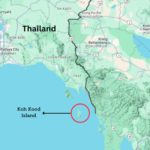India and China are two aspirants of gaining a foothold in the Indo-Pacific by deploying aggressive and diplomatic strategies to achieve their objectives. Moreover, the militarisation of the region by establishing key naval bases along with nuclear deterrence acts like a nightmare for the littoral states.
A German Politician, Karl Haushofer, first used the term Indo-Pacific to focus specifically on the rise of the Asian continent. The era after the Cold War has witnessed the rise of Asia with significant actors such as Japan, India and China growing comprehensively in terms of politics, economics, strategies, culture, diplomacy, soft power, military power, and technological advances, amongst others; hence, attracting worldwide attention, especially from the West. The struggle between America, India, Japan, and China to influence the geopolitical order of the Indo-Pacific region is worth noticing in multilateral partnerships such as QUAD to deter a common enemy, China. Moreover, the terminology ‘Indo-Pacific’ has changed for many nations, indicating not only a shift in the region’s nomenclature but also the region’s expanse.
The post-Cold War period saw the region as a confluence of two oceans and the littoral nations of the Indian Ocean and Pacific, which maintained and influenced the rules and order of the region. There is also an interplay of foreign policies of the parties that are more interested in the region, along with the international and regional norms that shape the geopolitical game in the region. Jeffrey Wilson says that the focus in the region has shifted from economic ties to security, especially maritime security, by quoting the term rescaling, which refers to a practice in which political processes are reshaped based on the spatial places they seek to include in these processes.
The concept of maritime security is increasing in the region due to several factors.
Firstly, India and China have ambitions to control the region using strategies such as String of Pearls and Necklace of Diamonds, which include strategic naval establishments. Secondly, according to the Shangri La Dialogue’s report of 2018, the region has become a hub of nuclear weapons, making it vulnerable to proxy conflicts between the major powers of the Indian Ocean. Adding on, the ongoing and exacerbated issue of illegal, unreported and unregulated fishing has led to the loss of marine biodiversity with severe implications such as the destruction of coral reefs, exploitation of exclusive economic zones, and threats to local fishermen, amongst others, with territorial disputes at the centre. In this context, Alfred Thayer Mahan’s theory is crucial, in “The Influence of Sea Power upon History”, Mahan exploredsea power during the seventeenth and eighteenth centuries with many different factors of achieving sea power. He has also outlined six elements of sea power viz geographic location, physical configuration, country’s expansion of the seashore, population and form of government. The paper delves into the Indian aspect of securing the region’s maritime security by delving into some national strategies to strengthen its foothold in the Indo-Pacific without violating international principles.
Apart from the Belt and Road Initiative, which focuses on establishing both maritime and territorial routes across South Asia, Southeast Asia, and the African region to Europe and the Middle East for giving landlocked China leverage on naval routes, thus enhancing the strategic culture, to further strengthen its foothold in the IOR (Indian Ocean Region), China banks on String of Pearls. First coined by Booz Allen in 2005 in his report titled ‘Energy Futures in Aisa; the strategy is focused on building diplomatic, political, and defence ties with the littoral states in the region by establishing ports. These ports are ‘Pearls’ of a string, signifying a power domain China is keen to secure in the IOR. In consonance with its objectives, the Chinese regime has heavily invested in the viable ports of Bangladesh (Chittagong), Myanmar (Sittwe and Kyaukpya), Pakistan (Gwadar) and Sri Lanka along with the recent secret agreement with the Maldives, which has made India insecure of losing its immediate and distant neighbours thereof.
To counter Chinese String, India introduced the Necklace of Diamonds in 2011 to counterbalance China with its build-up of ports and other infrastructural projects with the littoral states of IOR. These ports range from the north of China (Mongolia), eastwards into Japan, Vietnam, Singapore, and Indonesia, westwards to Seychelles, and straight to Central Asia in Iran and Oman. These nations hold a comprehensive significance for India for several reasons. Like BRI, India is using the diamond necklace to establish land and maritime trade and cooperation with the nations on which it depends for energy and security reasons. Moreover, due to the Middle Eastern states’ economic significance and rich oil reserves, India wants to establish an economic corridor like the Chinese-Pakistan Economic Corridor. Furthermore, the southeastern economies like Singapore, Myanmar, Indonesia and Vietnam are frustrated by Chinese patrolling in the South China Sea, which has limited their exposure to the exclusive economic zones; India, through its Act East policy, is focusing on its distant neighbourhood by strengthening bilateral relations by strengthening defence relations, especially with Singapore, Indonesia, and Seychelles. Last but not least, the ports in Oman hold the potential to make India the crown of the Indian Ocean due to their direct access to the Gulf of Aden and the Red Sea.
In addition to the Necklace of Diamond strategy, the Security and Growth for All in the Region is the maritime policy to bring out a framework for maritime cooperation with other littoral countries in the Indo-Pacific, which is reflective of the vision that Prime Minister Narendra Modi at the Shangri La Dialogue in 2018.
Quoting from the developments of a decade, in 2015, India signed an agreement with Mauritius to invest around $250 million in building an airfield, port, and communications hub. This position is crucial because the Mozambique Channel will serve as a surveillance outpost in the coming days. India has also placed central importance on Seychelles in its envisioned security framework by signing an agreement in 2015 to ensure access to the famous Assumption Islands for keeping a vigilant eye on the Mozambique Channel.
Most significant in this queue are the naval bases in the island group of Andaman and Nicobar Islands and Lakshadweep. The former islands, adjacent to the Strait of Malacca, are the only tri-service theatre command at Port Blair. In 2019, a well-stationed naval base, the Indian Naval Ship (INS) Kohassa, was built on northern Andaman Island to increase surveillance in the Bay of Bengal. In 2024, a new naval base, INS Jatayu, was established in Kavaratti to strengthen its foothold in the Arabian Sea and the surrounding region.
These strategies and the Quadrilateral Security Dialogue have brought together US and Indian navies to counter the rising Chinese influence in the Indo-Pacific. Both nations have signed a Basic Exchange and Co-operation Agreement to supply high-end equipment for real-time intelligence and information sharing. Additionally, India and Japan have agreed to pursue collaboration on Indo-Pacific Maritime Domain Awareness, calling for the linking of land, sea and air surveillance units of the navies to improve MDA in respective spheres; both nations have also signed the Acquisition and Cross Servicing Agreement to develop a better understanding of each other’s operational environments with the navies participating in bilateral and US-sponsored Multilateral Malabar exercises.
Thus, these strategies, other strategic engagements, and economic relations with the littoral nations are pivotal to counter China’s growing influence, ensuring a stable and secure regional order. India’s approach remains flexible and normative by respecting and balancing international maritime laws with national interests of strengthening maritime borders and fostering regional partnerships. This approach serves dual objectives of freedom of navigation and sovereignty of smaller states, the founding stones of India’s initiative.
On looking at the expansionist strategies of both India and China, the relevance of the Rimland theory of Nicholas Spykman which coincides with Mackinder’s inner crescent and comprises the coastal regions of Europe. Starting with China, it seeks to dominate the Rimland through string of pearls and South China Sea militarization while also getting counter responses from India in the form of Necklace of Diamonds as well as SAGAR and USA through the security dialogue. When analyzed carefully, the theory correctly predicts that global power struggles are concentrated along Eurasia’s coastal periphery with evident maneuvers from China, India and QUAD making Indo-Pacific emerging as the modern geopolitical fault line, where naval presence, infrastructure dominance, and strategic alliances shaping balance of power and security dilemma.






